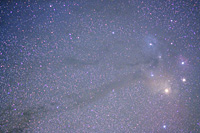
|
Deep Sky Astrophotography
|
|
|
These are some experiments with the goal to develop a way to utilize a DSLR for deep sky astrophotography without the need for a computer to be attached and without the use of special astrophoto image processing. In this way, the camera can be used on any scope without prior preparation or extra equipment (except for a coupling interface). The camera I'm using is a Nikon D70s with Hutech modification to replace the standard IR blocking filter with an H-alpha-friendly astronomical filter. It might be possible to do deep sky photography on certain objects (e.g. galaxies and globular clusters), but extended H-alpha response is virtually a necessity for emission nebulae. One problem with the Nikon D70s is the lack of a cable release attachment (like many electronic cameras). At the moment, for exposures >30 seconds, I'm using the IR remote to manually start and stop the exposure. Another problem is amplifier glow in one corner of the photos. For simplicity, I'm enabling internal noise reduction (NR), which requires that a second exposure be taken with the shutter closed of the same length as the real exposure. This is done automatically by the camera when NR is enabled. The downside to this is that each exposure takes twice as long as the intended shot. As you can see, it doesn't seem to completely remove the amp glow. In order to get the full dynamic range out of the camera, I'm saving a raw (NEF) format image + medium-quality JPG image. Advanced astrophotographers will object that the Nikon cameras (D70, D70s, D50) don't yield true raw files because of the default internal image processing, but for astrophoto "snapshots" I'm ignoring that as an inconsequential idiosyncrasy that will be lost in the noise and other image defects. For image processing, in order to keep things "simple" I'm doing all processing inside Photoshop. The exception will be using Registar for alignment of frames to be stacked.
|
||||||||||||||||


